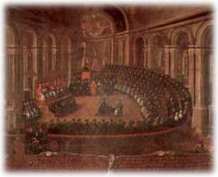History and development
 Already during the neolithic age, ancient populations inhabited the Doss
Trento, the isolated hill standing more than one hundred meters above the plain on the
right bank of the river Adige, and now crowned by the monument devoted to Cesare Battisti.
That height, called "Verruca" by Romans, has been used as a military stronghold,
while it is nowadays agreed that the roman "Tridentum" stood on the left side of
the Adige, beneath the modern town centre. The square of the roman town had its decumanus
underneath the present via Manci and via Roma, and the cardum ran parallel to what now is
via Belenzani.
Already during the neolithic age, ancient populations inhabited the Doss
Trento, the isolated hill standing more than one hundred meters above the plain on the
right bank of the river Adige, and now crowned by the monument devoted to Cesare Battisti.
That height, called "Verruca" by Romans, has been used as a military stronghold,
while it is nowadays agreed that the roman "Tridentum" stood on the left side of
the Adige, beneath the modern town centre. The square of the roman town had its decumanus
underneath the present via Manci and via Roma, and the cardum ran parallel to what now is
via Belenzani. Abandoned at the beginning of the Middle Age by the citizen looking for protection under the Doss (paleochristian ruins), Trento has been slowly repeopled; but we may talk of a real population increase only starting from the age of vicar Federico Vanga (in the XIII century), when the new city walls reached as far as the stream Fersina to the south and the ancient site of river Adige (which by that time flowed where now are Torre Vanga and Torre Verde) to the north. In 952 Trento, already been centre of a Longobard Duchy and afterwards of a Carolingian March, was detached by the emperor Otto I, together with the whole Verona March, from the Italian Kingdom and united to the Duchy of Bavaria, starting the political transition of the land from Italy to Germany. Concerned about having always at disposal the ways to Germany, the emperors endowed Trento bishops with the temporal power soon after year 1000. The prince-bishops were immediately involved, as Empire partisans, into the War of Investitures and in the struggle between Guelphs and Ghibellines; the man who brought peace back to the region was that very same Federico Vanga, bishop and emperor's vicar from 1207 to 1218, who also begun the reconstruction of the Duomo (the cathedral). In 1273 the bishops were usurped of their rights by the counts of Tirol, previously the principate lawmen; from then on, the prince-bishops's independence has been only formal, since actually they became part of the Tirol County and followed its destiny.
When the Counts of Tirol extinguished in 1363, Trento passed to Rudolph of Hausburg. In 1407, with a revolt of the people, the prior privileges were recovered temporarily; but the people captain Rodolfo Belenzani, who was relying on Venice aid, was defeated and killed. During the following years, Venice expansionism forced more and more Trento towards the Empire; in 1511, reconquered Rovereto, the bishop signed with Maximilian I a treaty for protection. From 1516 to 1539 Trento had been governed by cardinal Bernardo Clesio, who gave to the city that renaissance look which is still characteristic of the central streets; he built the new palace at Buonconsiglio Castle and the church of S. Maria Maggiore, and prepared the famous Council which, in different session, was held between 1545 and 1563, mostly in the Duomo and in S. Maria Maggiore. The town then reached her maximum splendour, under the guide of the bishops of Madruzzo family who had the power for more than a century.
The following ages are remembered only for the Spanish Succession campaigns, during which Trento was ineffectively sieged by marshal VEND‘ME, the french again occupations of 1796 and 1801 (the secularization of the principate dates 1802), the brief unions with Bavaria (1806-1809) and with the napoleonic Italian Kingdom (1810-1813); then, the long last century of Austria domain, during which a strong economical and urbanistic growth took place: the flow of river Adige was deviated, while the city has ever since been enlarged, to the north and expecially to the south, up to the last world conflict, with residential quarters and industrial plants.